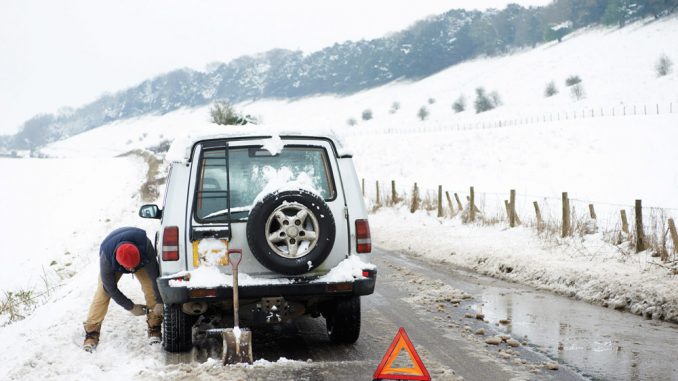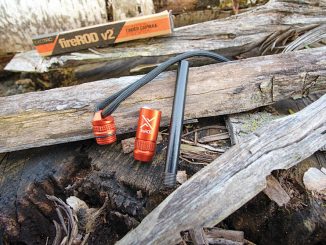
Winter is No Time to be Without a Plan
For many years, I led Saturday hiking classes through the local college into various wild areas during winter season. One day in December, I was leading one of these classes in the mountains of the Angeles National Forest. We had hiked several miles up a trail to the approximately 3,000-foot level to our destination, Echo Mountain, the site of a tavern and hotel many decades earlier; it was now all ruins.
We spent a little time wandering around the sprawling mountaintop ruins and then created a small fire in front of an old still-standing fireplace. It was challenging to make even a small fire, because rain had been falling for the previous few days. The day was windy, and there was old snow on the ground.
“OUR FIRE WAS NEVER THAT LARGE, BUT IT WAS ENOUGH TO HEAT SOME SOUP AND TO WARM THE FIREPLACE STONES JUST ENOUGH TO RADIATE HEAT FOR OUR GROUP OF A DOZEN OR SO WHO ALL HUDDLED VERY CLOSE TO IT.”
We collected dry pine needles and the dead leaves from some of the various conifers that had been planted there decades earlier. We even added pieces of sandwich wrappers and other odd bits of paper in order to get the fire going and keep it going. Everyone gathered closely together to warm up on the cold day.
Our fire was never that large, but it was enough to heat some soup and to warm the fireplace stones just enough to radiate heat for our group of a dozen or so who all huddled very close to it.
Finally, after we’d all had some hot tea or soup, we packed up, and it was just in time. It had been very cold, and as we watched, the very light rain was freezing before it hit the ground — it was turning to snow. It steadily grew heavier, as we all donned our packs and headed toward the trail back home.
As we began walking, eager to get back down the trail and out of the snow, a woman and about 10 young girls appeared out of the light snowy mist, like an apparition. I wondered where they’d come from.

One of the author’s School of Self-Reliance classes learns about several ways to make fire.
“Do you have any matches?” the woman asked, with great expectation apparent in her voice. She explained that it was their second day of a five-day campout with her Girl Scouts, and that she’d used up all her book matches the previous day.
“Really?” I said, incredulously. I thought to myself, “You came up here with all these girls in the snow for five days in the winter and all you brought were book matches?”
It was hard to contain myself. I mean, it’s one thing to just leave home without the things you need if you’re by yourself, but when you’re responsible for the welfare of others, you need to take extra precautions.
I told the woman that I did not carry book matches, since it’s too easy for the book matches to get wet or moist and not work. I sometimes carry stick matches but I had none with me. I didn’t even have a cigarette lighter, which I try to always carry.
But I’d made our earlier soup fire with the magnesium fire starter that I always carry on my keychain. I figured we’re on our way out, and these folks are in dire need. I took the fire starter off my keychain and showed the Girl Scout leader how to use it.

Nicole DeWeese shows two of the most essential items that should always be carried: a knife and fire starter. Additional important gear is on the table.
I scraped some of the magnesium block into some scrap paper that we sheltered from the light snow, and then I scraped the ferrocerium insert so that a shower of sparks ignited the magnesium. Presto! A bright fire. The lady smiled and graciously accepted my fire starter, and I told her to be sure and never leave home in the future without at least two ways — preferably three — to make a fire.
Do you have a knife for using the fire starter? I asked her. Yes, she nodded, holding up her Swiss Army knife. The Girl Scouts all seemed cold, and they huddled about her like baby chicks around the mother hen.
After a bit of small talk, she and her little children disappeared back into the fog and snow. I presume they made it out OK in the following days because I didn’t read about them in the local newspaper.

The holy trinity of survival: a knife, fire starter and cordage.
Needless to say, on our hike out, my hiking class had a lively discussion about the need to carry a fire starter, and everyone speculated on how well the small Girl Scout group would do in the snow during the next few days.
ALWAYS BE PREPARED
This incident emphasized the need to be prepared with appropriate gear when going on wilderness expeditions. This means having not just the basic gear that you know you’ll need but the gear that is appropriate for the season. And one of the most basic of all gear is some way to make a fire!
“I SCRAPED SOME OF THE MAGNESIUM BLOCK INTO SOME SCRAP PAPER THAT WE SHELTERED FROM THE LIGHT SNOW, THEN I SCRAPED THE FERROCERIUM INSERT SO THAT A SHOWER OF SPARKS IGNITED THE MAGNESIUM. PRESTO! A BRIGHT FIRE.”
Rain is the most challenging, more challenging than snow in my opinion. If you’re going to spend the night in the outdoors in cold and wet weather, you need appropriate clothing, rain coverings (such as ponchos), a waterproof shelter of some sort, and having a way to make a fire is a big plus. Regardless of the circumstances, I find that I always need to carry a knife, a fire starter (ideally several), and cordage (for shelter and other uses).

Using a magnesium fire starter is not difficult, but it takes a little experience to become proficient with it.

Gary Gonzales trains School of Self-Reliance students how to master the bow and drill for making fire.
You could not make a fire in a modern tent unless you had a way to control a very small fire. In a wilderness shelter, such as a brush shelter, you still don’t want a fire inside because the entire shelter is very flammable. In wet and cold weather, you’d have to build the fire slightly outside the shelter so you get the benefit of some of the heat. We’ve actually heated rocks in a fire and rolled the rocks into our brush shelter so the rocks would radiate heat.
Though I have no idea whatever ultimately happened to the woman and her Girl Scouts, I hope she found some sheltered spot to spend the night, such as under a bridge, in a cave, or under a bluff where there is some natural protection from the elements.
DON’T JUDGE
I noted that part of the conversation from my hiking class about this woman and her girls included criticism that she could be so stupid and foolish to run out of matches.
My ears really perked up and I stopped the hike temporarily. I told them not to judge others. Then I asked the person who was so harsh with the Girl Scout leader to show me her fire starter. She didn’t have one. I asked to see her knife. OK, she had a little pen knife. I asked to see her first aid kit. Nothing.
I asked her for her plan for spending the night in the snow, if she should happen to get stuck in the snow. She said, “Well, that’s not fair. I didn’t come here expecting to spend the night. I came just for the day.”
“Yes,” I told her, “correct. But stuff happens, and if something happened to you today, you could be in the same, if not worse, condition as that woman. Anyway, do you really think she expected it to snow?”
REPEAT: ALWAYS BE PREPARED
I wasn’t trying to defend the actions of the Girl Scout leader, who presumably was simply volunteering her time so that the girls would have a learning experience. Still, the essence of survival preparedness is that you’re preparing for the unexpected. And truth be told, that’s an impossible task, but there are ways to break it down so you have some hope of coming out alive.

Using a bow and drill is one of the more challenging methods of starting a fire, but it’s still a valuable skill to learn.
AUTOMOBILE
Many remote emergencies occur because your car failed to start. Always carry blankets, food and water in your car. Even if you have to stay in the woods with your car for a few days, you should be comfortable and properly fed. You can make a fire to stay warm and to draw attention to your location.
“FIELD RESEARCH HAS DEMONSTRATED THAT WEARING LIGHTER LAYERS (RATHER THAN ONE THICK COAT) IS MUCH MORE PRACTICAL AND COMFORTABLE.”

Keith Farrar (left) shows Roman (middle) and discusses the uses of a rain poncho that is commercially available.
PLANNING
Yes, planning is paramount. Get a map of where you intend to go. Will rising rivers make it difficult or impossible to cross roads or trails? Will you even be able to get to your chosen location? Will it be possible to get assistance if you run into trouble? Maybe you should plan your journey to a safer area at that time of the year? Be sure to tell someone else your itinerary, wherever you decide to go.

Boy Scout leader Francisco Loaiza shows some basic insulating materials, such as the emergency space blanket he is holding, and various tarps and plastic bags.

A student tries the Mylar emergency space blanket. This is effective at retaining body heat, keeping covered areas dry and blocking the wind.
SYSTEMS
Remember the 10 Essentials? I prefer to think of them as 10 (or so) systems rather than 10 items.
These systems allow you to deal with whatever situations you might find yourself in. Still, time of the year (Is it very hot in summer, or very cold?), location and other factors will strongly influence what items you actually need. For winter, your needs will be very specific.

Learn some knots so you can convert a poncho or tarp into a tent, and use cordage for many other purposes.
Clothing and shelter fall into the category of insulation. In winter, you want to stay dry and warm.
CLOTHING
Your clothing is your shelter at a short distance. Choose your garments carefully. Field research has demonstrated that wearing lighter layers (rather than one thick coat) is much more practical and comfortable. Dressing in layers means you can add little by little as needed and take off one or more layers when things warm up. Your outer layer needs to be waterproof, and one of the best outer garments is a large hooded tarp, especially one with grommets because it can double as a small tent. This type of tarp is usually large enough that you can wear a pack under it and still stay warm.
SHELTER
If you’re expecting rain or snow, you should have a waterproof shelter. At the very least, you should carry a plastic tube tent, which provides no insulation but will give you protection from the rain and snow.
“IF YOU’RE GOING TO SPEND THE NIGHT IN THE OUTDOORS IN COLD AND WET WEATHER, YOU NEED APPROPRIATE CLOTHING, RAIN COVERINGS (SUCH AS PONCHOS), A WATERPROOF SHELTER OF SOME SORT, AND HAVING A WAY TO MAKE A FIRE IS A BIG PLUS.”
We’ve carried large plastic sheets on occasion when we had a group and we wanted some cover for our activities. We purchased a 10-by-20-foot plastic tarp from a hardware store and stretched it out by rope so we had rain protection at our camp.

Some of the author’s students learn how to turn a poncho into an emergency tent from instructor Keith Farrar.

Keith Farrar shows the knots that are most useful for turning a tarp into a tent.
FIRE
It would be hard for me to imagine a viable winter camp without a fire. The fire keeps you dry, warms you and gives you a way to always have a hot beverage and a warm meal. The best tool to have a ready-to-go fire is a butane lighter. Carry several. Yes, bring backups too, such as a magnifying glass (no good when it’s overcast or dark), ferrocerium rods, and even matches in a waterproof container. Bring several methods for getting that fire going.

Survival instructors show how to set up a tube tent, which requires only some cordage and two trees or other similar anchors to tie it to.
SUN PROTECTION
Sunburn doesn’t happen just in summer. If you’re in snow, the sun can reflect off the snow and give you sunburns or even temporary blindness. If you’re on the water, you also need some protection. You need a hat, sunglasses, lip balm and a broad-spectrum sunscreen with an SPF of 30 or more, or sunblock.

Students at a college survival course learn how to set up a commercial pop-up tent.
FIRST AID
Remember, your knowledge of how to handle basic medical emergencies is far more important than the stuff in your kit. If you don’t know how to respond, the stuff in your kit is not very useful. So, yes, get a kit, but also enroll in an emergency first aid course to learn real world skills. There are many portable first aid kits available for purchase in stores ranging from supermarkets to pharmacies to online sources. Buy the kit that fits your particular needs.
In the case of cold weather, you need to be aware of hypothermia in yourself and others. See sidebar about hypothermia below.
NUTRITION
You should plan for your immediate nutritional needs, as well as for an intermediate length of time. This means carry nutritious foods that will keep for a long period of time, such as dried meat or vegetarian jerky, dried fruits and nuts and whole grain crackers.

Students work on building a half-dome shelter in the woods, with a raised bed platform.
WATER PURIFICATION
Hunters and others have become dehydrated and gone into shock because they didn’t realize their body needed water. You may not feel thirsty in winter, but your body still needs water. Besides carrying some water, you should also carry a means to purify water, whether it’s a small Sawyer water purifier or one of the pump models, such as a Timberline or MSR. If you’re with a group in winter, you should make sure that everyone drinks regularly throughout the day.
“WILL IT BE POSSIBLE TO GET ASSISTANCE IF YOU RUN INTO TROUBLE? MAYBE YOU SHOULD PLAN YOUR JOURNEY TO A SAFER AREA AT THAT TIME OF THE YEAR? BE SURE TO TELL SOMEONE ELSE YOUR ITINERARY, WHEREVER YOU DECIDE TO GO.”

If you have no tarps or tents, you should learn how to construct a lean-to or debris shelter in the wilderness.
There are other products and systems that you should be aware of for any wilderness travel year round. Here we are addressing only those that are most pertinent to winter.
RECOGNIZING HYPOTHERMIA
When you’re on a remote expedition, you’re as strong as the weakest link in your group. Yes, you might be feeling fine, but what about that other guy in your group? Watch for the “umbles” so you can take action to help someone who is going into hypothermia.
Look first for shivering, and then look for the “umbles.” The person fumbles — they are losing fine motor control in their fingers. They can’t handle their keys, a knife or maybe a fire starter. They stumble — they are losing blood to the feet and losing control. Then they mumble — they are losing control of the tongue. Soon, they grumble, saying they do not care. Then you know they are losing overall control.
Treat them for hypothermia! Get some warm coverings and get them to a toasty fire. Make some warm drinks or chocolate and make sure they drink it.
Sometimes it’s raining or snowing and you can’t go home. Do everything you can to help the weakest link of your group. Keep that fire going, get and stay dry and keep the warm beverages or food flowing.





Be the first to comment